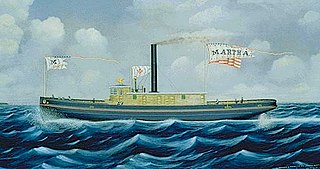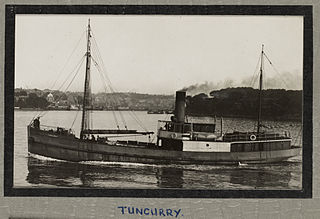Related Research Articles

USS Advance, the second United States Navy ship to be so named, was later known as USS Frolic, and was originally the blockade runner Advance captured by the Union Navy during the latter part of the American Civil War. She was purchased by the Union Navy and outfitted as a gunboat and assigned to the blockade of the waterways of the Confederate States of America. She also served as dispatch ship and supply vessel when military action eventually slowed.

Princess Royal was a British merchant ship and blockade runner that became a cruiser in the Union Navy during the American Civil War and later returned to civilian service.
Numerous British vessels have borne the name Prince of Wales, after the then current Prince of Wales, the title borne by the heir-presumptive to the throne of the United Kingdom.

USS Santiago de Cuba was a side-wheel steamship acquired by the Union Navy during the first year of the American Civil War. She was outfitted as a gunboat with powerful 20-pounder rifled guns and 32-pounder cannon and was assigned to the Union blockade of the Confederate States of America. She was notably successful in this role, capturing several blockade runners. Her last major action of the war was the assault on Fort Fisher, during which seven of her crew won the Medal of Honor.

The Pacific Mail Steamship Company was founded April 18, 1848, as a joint stock company under the laws of the State of New York by a group of New York City merchants. Incorporators included William H. Aspinwall, Edwin Bartlett, Henry Chauncey, Mr. Alsop, G.G. Howland and S.S. Howland.

The first USS Gettysburg was a steamer in the United States Navy. The ship was built in Glasgow, Scotland, in 1858, named RMS Douglas, and operated by the Isle of Man Steam Packet Company in the United Kingdom between Liverpool, England, and Douglas on the Isle of Man until November 1862. She was then sold to Cunard, Wilson & Company on behalf of the Confederate agents Fraser, Trenholm & Company for use by the Confederate States of America during the American Civil War. Renamed Margaret and Jessie, she operated as a blockade runner until her capture by the Union on 5 November 1863. The ship then was commissioned into the Union Navy on 2 May 1864 as USS Gettysburg.

A & J Inglis, Ltd, was a shipbuilding firm founded by Anthony Inglis and his brother John, engineers and shipbuilders in Glasgow, Scotland in 1862. The firm built over 500 ships in a period of just over 100 years. Their Pointhouse Shipyard was at the confluence of the rivers Clyde and Kelvin. They constructed a wide range of ships, including Clyde steamers, paddle steamers and small ocean liners. In wartime, they built small warships, and in the period after World War II, they built a number of whalers.

Estrella was a paddle steamship built by Samuda Brothers in London in 1853 for the Magdalena Steam Navigation Company's commercial services in present-day Colombia. In 1862 she was sold to United States owners and briefly used as a Union Army transport before being acquired by the Union Navy. She served as the armed steamship USS Estrella during the remainder of the American Civil War, carrying three heavy guns as well as two howitzers for shore bombardment.
USS Tristram Shandy was a 444-ton steamer and blockade runner captured by the Union Navy during the American Civil War.

USS Violet was a 166-ton steamer acquired by the U.S. Navy for use during the American Civil War.

Argo was an iron screw steamer launched in 1853. She was the first screw steamship to circumnavigate the Earth. She was also a Troopship during the tail end of the Crimean War.

The Tuncurry was a wooden carvel screw steamer built in 1903 at Cape Hawke in the Australian state of New South Wales, that was wrecked when she sprang a leak whilst carrying explosives, cement, whiskey, jam and other general cargo between Sydney and Brisbane. She was lost off Barrenjoey Head, Broken Bay, New South Wales on 22 October 1916.

During the American Civil War, blockade runners were used to get supplies through the Union blockade of the Confederate States of America that extended some 3,500 miles (5,600 km) along the Atlantic and Gulf of Mexico coastlines and the lower Mississippi River. The Confederacy had little industrial capability and could not indigenously produce the quantity of arms and other supplies needed to fight against the Union. To meet this need, numerous blockade runners were constructed in the British Isles and were used to import the guns, ordnance and other supplies that the Confederacy desperately needed, in exchange for cotton that the British textile industry needed greatly. To penetrate the blockade, these relatively lightweight shallow draft ships, mostly built in British shipyards and specially designed for speed, but not suited for transporting large quantities of cotton, had to cruise undetected, usually at night, through the Union blockade. The typical blockade runners were privately owned vessels often operating with a letter of marque issued by the Confederate government. If spotted, the blockade runners would attempt to outmaneuver or simply outrun any Union Navy warships on blockade patrol, often successfully.
William Patterson Shipbuilders was a major shipbuilder in Bristol, England during the 19th century and an innovator in ship construction, producing both the SS Great Western and SS Great Britain, fine lined yachts and a small number of warships.
SS United States was a merchant steamship launched in 1864 and lost off Cape Romain, South Carolina, in 1881. She was the most expensive steamer built by the American shipbuilding firm of S. Gildersleeve & Son, which built 120 vessels. The vessel was named for her country and sported the United States' national symbol, an American eagle, as her figurehead.
Several ships have been named Woodlark after the woodlark:
Several vessels have been named Gibraltar, for Gibraltar:
References
- ↑ "Wreck of the Charlotte Troop-ship" . The Express. No. 2590. London. 8 December 1854. p. 4. Retrieved 28 December 2023– via British Newspaper Archive.
- ↑ "Loss of the Ship "Charlotte" in Algoa Bay" . Illustrated London News. Vol. XXV, no. 721. 30 December 1854. pp. 3–4. Retrieved 29 December 2023– via British Newspaper Archive.
- ↑ Wise, Stephen R. (1991). Lifeline of the Confederacy: Blockade Running During the Civil War. Columbia: University of South Carolina Press. p. 293. ISBN 0-87249-799-2.
- ↑ "Charlotte". Scottish Built Ships. Caledonian Maritime Research Trust. Retrieved 28 December 2023.
- ↑ "Charlotte (2126597)" . Miramar Ship Index . Retrieved 2023-12-28.
- ↑ "Museumschip Tordino". Maritiem Digitaal (in Dutch). Oudenburg. Retrieved 28 December 2023.